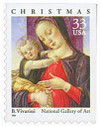
1999 33c Traditional Christmas: Madonna and Child
# 3355 - 1999 33c Traditional Christmas: Madonna and Child
$0.35 - $3.20
U.S. #3355
Traditional Christmas
Traditional Christmas
Issue Date: October 20, 1999
City: Washington, DC
Quantity: 1,555,560,000
Printed By: Banknote Corporation of America
Printing Method: Lithographed
Perforations: Serpentine Die Cut 11.25
Color: Multicolored
City: Washington, DC
Quantity: 1,555,560,000
Printed By: Banknote Corporation of America
Printing Method: Lithographed
Perforations: Serpentine Die Cut 11.25
Color: Multicolored
Bartolomeo Vivarini’s painting “Madonna and Child” is featured in the 1999 Traditional Christmas postage stamp issued by the United States. The Vivarini family, whose original surname was da Murano, included several artists who operated an important workshop in Venice during the 15th century. Bartolomeo (1432-1499) began his artistic career studying under his brother, Antonio (1415-1484). He later opened his own studio.
Bartolomeo’s creative style was greatly influenced by other Renaissance artists, especially Francesco Squarcione and Donatello. Vivarini’s painting of St. John of Capistrano (1459) now hangs in the Louvre in Paris. Most of his distinguished works were created after 1464, a date which represents a turning point in Vivarini’s career. As Vivarini’s popularity grew, he was forced to use assistants to finish the large number of paintings he was commissioned to complete. He also created altar pieces for Italian churches. Vivarini’s last work was a triptych (three painted or carved panels that are hinged together) which he created in northern Italy in 1491.
Vivarini’s vibrant “Madonna and Child” (c. 1475) is uncharacteristic of his usual somber style. Figures in the painting resemble sculptures because of Vivarini’s use of tempera on a wood panel.
The original painting hangs in the National Gallery of Art in Washington, D.C.
U.S. #3355
Traditional Christmas
Traditional Christmas
Issue Date: October 20, 1999
City: Washington, DC
Quantity: 1,555,560,000
Printed By: Banknote Corporation of America
Printing Method: Lithographed
Perforations: Serpentine Die Cut 11.25
Color: Multicolored
City: Washington, DC
Quantity: 1,555,560,000
Printed By: Banknote Corporation of America
Printing Method: Lithographed
Perforations: Serpentine Die Cut 11.25
Color: Multicolored
Bartolomeo Vivarini’s painting “Madonna and Child” is featured in the 1999 Traditional Christmas postage stamp issued by the United States. The Vivarini family, whose original surname was da Murano, included several artists who operated an important workshop in Venice during the 15th century. Bartolomeo (1432-1499) began his artistic career studying under his brother, Antonio (1415-1484). He later opened his own studio.
Bartolomeo’s creative style was greatly influenced by other Renaissance artists, especially Francesco Squarcione and Donatello. Vivarini’s painting of St. John of Capistrano (1459) now hangs in the Louvre in Paris. Most of his distinguished works were created after 1464, a date which represents a turning point in Vivarini’s career. As Vivarini’s popularity grew, he was forced to use assistants to finish the large number of paintings he was commissioned to complete. He also created altar pieces for Italian churches. Vivarini’s last work was a triptych (three painted or carved panels that are hinged together) which he created in northern Italy in 1491.
Vivarini’s vibrant “Madonna and Child” (c. 1475) is uncharacteristic of his usual somber style. Figures in the painting resemble sculptures because of Vivarini’s use of tempera on a wood panel.
The original painting hangs in the National Gallery of Art in Washington, D.C.










